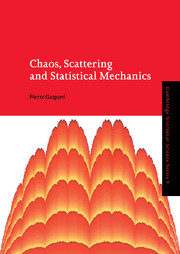Book contents
- Frontmatter
- Contents
- Preface
- Introduction
- Chapter 1 Dynamical systems and their linear stability
- Chapter 2 Topological chaos
- Chapter 3 Liouvillian dynamics
- Chapter 4 Probabilistic chaos
- Chapter 5 Chaotic scattering
- Chapter 6 Scattering theory of transport
- Chapter 7 Hydrodynamic modes of diffusion
- Chapter 8 Systems maintained out of equilibrium
- Chapter 9 Noises as microscopic chaos
- Chapter 10 Conclusions and perspectives
- References
- Index
Chapter 5 - Chaotic scattering
Published online by Cambridge University Press: 30 January 2010
- Frontmatter
- Contents
- Preface
- Introduction
- Chapter 1 Dynamical systems and their linear stability
- Chapter 2 Topological chaos
- Chapter 3 Liouvillian dynamics
- Chapter 4 Probabilistic chaos
- Chapter 5 Chaotic scattering
- Chapter 6 Scattering theory of transport
- Chapter 7 Hydrodynamic modes of diffusion
- Chapter 8 Systems maintained out of equilibrium
- Chapter 9 Noises as microscopic chaos
- Chapter 10 Conclusions and perspectives
- References
- Index
Summary
Classical scattering theory
Motivations
Matter is often studied by scattering with beams of particles such as photons, electrons, neutrons, or others. The quantities of interest are the cross-sections which give the effective surface offered by the target for the realization of a certain scattering event. Scattering processes are usually conceived in a statistical approach. For instance, a cross-section cannot be determined by a single collision but by a statistical ensemble of collisions with a uniform distribution of the incoming impact parameters. In this regard, a natural relation appears between scattering theory and the Liouvillian dynamics.
Many different processes may be considered in scattering theory, for instance elastic or inelastic collisions (Joachain 1975). Among the latter, the reaction processes between molecules or nuclei are of particular importance because they play a crucial role in the transformation of matter. Beside the cross-sections, other important quantities are the reaction rates which characterize the time evolution of statistical ensembles during reactions. The rates have the inverse of a time as unit. We may thus expect that reaction rates belong to the same class of properties as the relaxation rates of Liouvillian dynamics. This is the case, in particular, for unimolecular reactions which are dissociation processes (Gaspard and Rice 1989a, 1989b). The reaction rates can here be assimilated with the lifetimes of the metastable states of the transition complex, i.e., of the transient states formed when the fragments of the reactions are still in interaction. Here also, these lifetimes are essentially statistical properties of the time evolution instead of properties of individual trajectories of the system.
- Type
- Chapter
- Information
- Chaos, Scattering and Statistical Mechanics , pp. 171 - 223Publisher: Cambridge University PressPrint publication year: 1998

